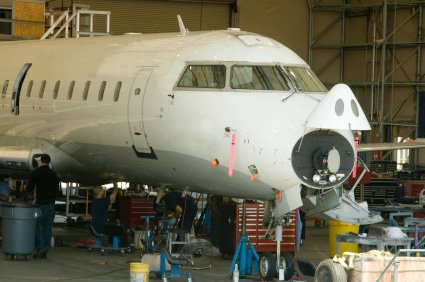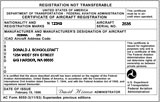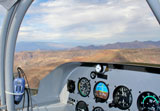|
Aircraft Inspections
FAR 43 Appendix D outlines the items to be inspected. I have listed them below for your convenience. You must present evidence that the 100-hour type aircraft inspection was accomplished, and
the aircraft was found airworthy by one of the following persons: 1. The manufacturer; 2. The holder of an appropriately rated repair station certificate issued under FAR 145; 3. The holder of a mechanic certificate issued under FAR 65; or 4. The holder of a certificate issued under FAR 121 and having a maintenance and inspection organization appropriately rated for the type of aircraft involved. Compliance with the inspection requirement can be demonstrated by one of the following methods: 1. The applicant may have the aircraft inspected in accordance with the performance rules for 100-hour inspections set forth in FAR 43.15(c)(1). 2. The FAA may accept a recent 100-hour aircraft inspection, whether performed in the United States or in any other country where the aircraft previously was located while the aircraft was on the U.S. registry: a) When the inspection was performed within 30 days before the date of application for a standard airworthiness certificate. b) When the inspection was accomplished by an approved maintenance organization appropriately certificated by the CAA of a country with which the United States has a bilateralmaintenance agreement and that meets the requirements as defined in FAR 21.183(d)(2). FAR 43.15(c) is where you find the performance rule for 100 hour and annual aircraft inspections. This section of the regulations refers you to FAR 43 Appendix D for a list of items that must be included in the inspection. So, the inspection required for used aircraft when seeking a standard or export certification must be equivalent in scope and detail to those applicable items listed in FAR 43 Appendix D as follows: (a) Each person performing an annual or 100-hour inspection shall, before that inspection, remove or open all necessary inspection plates, access doors, fairing, and cowling. He shall thoroughly clean the aircraft and aircraft engine. (b) Each person performing an annual or 100-hour inspection shall inspect (where applicable) the following components of the fuselage and hull group: (1) Fabric and skin—for deterioration, distortion, other evidence of failure, and defective or insecure attachment of fittings. (2) Systems and components—for improper installation, apparent defects, and unsatisfactory operation. (3) Envelope, gas bags, ballast tanks, and related parts—for poor condition. (c) Each person performing an annual or 100-hour inspection shall inspect (where applicable) the following components of the cabin and cockpit group: (1) Generally—for uncleanliness and loose equipment that might foul the controls. (2) Seats and safety belts—for poor condition and apparent defects. (3) Windows and windshields—for deterioration and breakage. (4) Instruments—for poor condition, mounting, marking, and (where practicable) improper operation. (5) Flight and engine controls—for improper installation and improper operation. (6) Batteries—for improper installation and improper charge. (7) All systems—for improper installation, poor general condition, apparent and obvious defects, and insecurity of attachment. (d) Each person performing an annual or 100-hour inspection shall inspect (where applicable) components of the engine and nacelle group as follows: (1) Engine section—for visual evidence of excessive oil, fuel, or hydraulic leaks, and sources of such leaks. (2) Studs and nuts—for improper torquing and obvious defects. (3) Internal engine—for cylinder compression and for metal particles or foreign matter on screens and sump drain plugs. If there is weak cylinder compression, for improper internal condition and improper internal tolerances. (4) Engine mount—for cracks, looseness of mounting, and looseness of engine to mount. (5) Flexible vibration dampeners—for poor condition and deterioration. (6) Engine controls—for defects, improper travel, and improper safetying. (7) Lines, hoses, and clamps—for leaks, improper condition and looseness. (8) Exhaust stacks—for cracks, defects, and improper attachment. (9) Accessories—for apparent defects in security of mounting. (10) All systems—for improper installation, poor general condition, defects, and insecure attachment. (11) Cowling—for cracks, and defects. (e) Each person performing an annual or 100-hour inspection shall inspect (where applicable) the following components of the landing gear group: (1) All units—for poor condition and insecurity of attachment. (2) Shock absorbing devices—for improper oleo fluid level. (3) Linkages, trusses, and members—for undue or excessive wear fatigue, and distortion. (4) Retracting and locking mechanism—for improper operation. (5) Hydraulic lines—for leakage. (6) Electrical system—for chafing and improper operation of switches. (7) Wheels—for cracks, defects, and condition of bearings. (8) Tires—for wear and cuts. (9) Brakes—for improper adjustment. (10) Floats and skis—for insecure attachment and obvious or apparent defects. (f) Each person performing an annual or 100-hour inspection shall inspect (where applicable) all components of the wing and center section assembly for poor general condition, fabric or skin deterioration, distortion, evidence of failure, and insecurity of attachment. (g) Each person performing an annual or 100-hour inspection shall inspect (where applicable) all components and systems that make up the complete empennage assembly for poor general condition, fabric or skin deterioration, distortion, evidence of failure, insecure attachment, improper component installation, and improper component operation. (h) Each person performing an annual or 100-hour inspection shall inspect (where applicable) the following components of the propeller group: (1) Propeller assembly—for cracks, nicks, binds, and oil leakage. (2) Bolts—for improper torquing and lack of safetying. (3) Anti-icing devices—for improper operations and obvious defects. (4) Control mechanisms—for improper operation, insecure mounting, and restricted travel. (i) Each person performing an annual or 100-hour inspection shall inspect (where applicable) the following components of the radio group: (1) Radio and electronic equipment—for improper installation and insecure mounting. (2) Wiring and conduits—for improper routing, insecure mounting, and obvious defects. (3) Bonding and shielding—for improper installation and poor condition. (4) Antenna including trailing antenna—for poor condition, insecure mounting, and improper operation. (j) Each person performing an annual or 100-hour inspection shall inspect (where applicable) each installed miscellaneous item that is not otherwise covered by this listing for improper installation and improper operation. In summary, regardless of the aircraft maintenance program being used, the regulations require that the aircraft inspections for a standard or export certification be at least equivalent in scope and detail to the aircraft inspections outlined above.
Go from this Aircraft Inspections page back to the Standard Airworthiness Certification Page |










